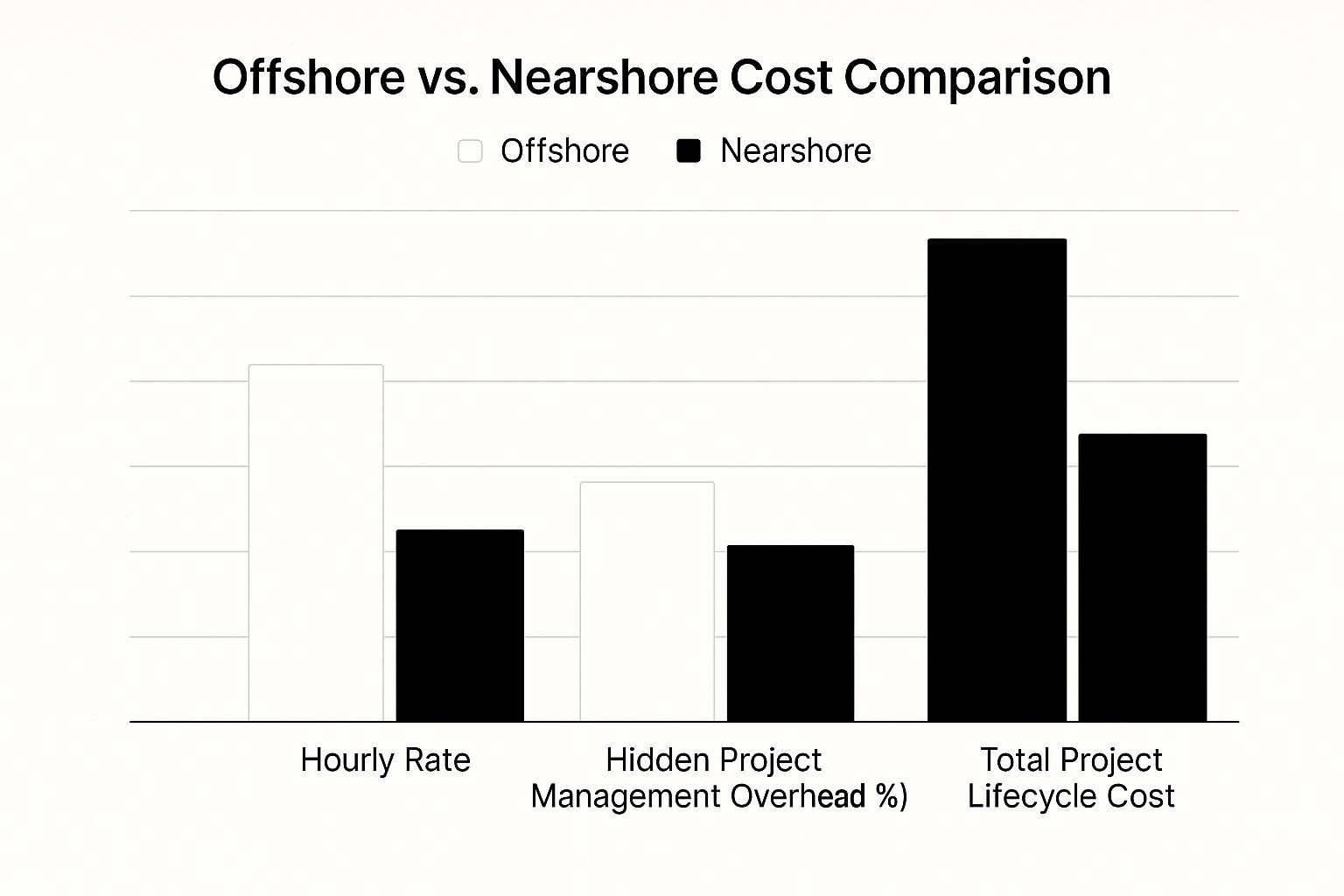Offshore vs Nearshore A Modern Guide
- Ron Smith

- Oct 15
- 12 min read
Deciding between an offshore and a nearshore team isn't just about the bottom line anymore; it's a fundamental choice that shapes your company's agility and long-term growth. The distinction seems simple on the surface: Offshore promises major cost reductions by tapping into talent pools in distant countries, but often at the expense of time zone alignment. Nearshore, on the other hand, strikes a powerful balance, delivering solid savings while keeping your team in sync through real-time collaboration and closer cultural ties.
Choosing Your Global Talent Strategy

The offshore vs. nearshore debate has evolved. It’s no longer a simple cost-cutting exercise but a strategic move to build a resilient, highly skilled, and scalable contingent workforce. As companies get smarter about managing global talent, the conversation has shifted from pure labor arbitrage to a focus on accessing specialized skills and accelerating project delivery. This trend is amplified by advancements in AI and technology that are reshaping workforce management.
Software development has truly taken over, now making up a staggering 64% of all outsourced services across both models. While offshore teams can offer developer rates that are 40–70% lower than onshore, the reality is that their project success rate can hover as low as 60%.
Nearshore teams tell a different story. Despite slightly higher rates, they deliver an impressive 28% faster time-to-market and boast an 80% project success rate. It’s no surprise, then, that 90% of companies now report getting better results with nearshore partners.
Understanding the Key Differences
To make the right call, you have to look past the hourly rates. Factors like communication overhead, cultural fit, and the complexity of your projects are what truly determine success. The best model is the one that fits your specific goals and operational rhythm, plain and simple.
Getting a firm grasp on these differences is the first step toward building a successful global talent acquisition strategy.
Quick Comparison: Offshore vs. Nearshore at a Glance
This table breaks down the core trade-offs at a high level, giving you a quick snapshot of what to expect from each model.
Factor | Offshore | Nearshore |
|---|---|---|
Cost Savings | High (often 50-70% lower) | Moderate (often 30-50% lower) |
Time Zone Overlap | Minimal (8-12 hour difference) | High (0-3 hour difference) |
Communication | Asynchronous (delayed feedback) | Real-time (immediate collaboration) |
Cultural Alignment | Can be challenging | Often strong and similar |
Travel & Oversight | Costly and time-consuming | Easier and more affordable |
Ideal Use Case | Well-defined, non-urgent tasks | Agile, collaborative, complex projects |
Ultimately, the choice depends on what you value most: maximum savings for straightforward tasks or better collaboration for complex, fast-moving projects.
Emerging trends in contingent labor show a move beyond traditional models. A new kind of staff augmentation is what we offer, using AI to connect companies with elite global talent at the most affordable cost. This modern approach focuses on skill and compatibility first, creating a truly global talent pool without geographical limitations.
A Nuanced Comparison of Outsourcing Models
To get the offshore vs. nearshore debate right, you have to look past the sticker price. The real decision hinges on how each model plugs into your daily operations—or creates friction. It’s a game of hidden costs, missed opportunities, and operational drag.
The most obvious hook for offshore is the low hourly rate. You’ll see immediate savings on paper, no question. But those numbers don't account for the management overhead needed to bridge a 12-hour time gap or the cost of rework when a simple question takes 24 hours to answer.
Nearshore flips the script. The hourly rate is higher, sure, but the Total Cost of Engagement is often much lower. Why? Because smoother workflows, less management, and fewer communication breakdowns mean you get things right the first time.
The Real Cost of a Time Zone Gap
Communication is everything, and this is where the models truly diverge. Offshore teams are often 8-12 hours ahead or behind you, forcing an asynchronous workflow. A quick clarification becomes a day-long delay. Project momentum dies in the waiting.
Nearshore partners, on the other hand, are only 0-3 hours apart. This isn't just about convenience; it's about speed. It means real-time collaboration, daily stand-ups that actually work, and the ability to jump on a call to solve a problem now, not tomorrow.
The core difference isn't just about convenience; it's about velocity. Real-time communication directly translates to faster decision-making, quicker iteration cycles, and a more adaptive project team.
It’s Not Just About Code, It’s About Culture
Cultural alignment is the unspoken factor that can make or break a team. Nearshore talent pools in Latin America often share strong cultural and professional ties with North American businesses. This translates to a shared understanding of deadlines, direct feedback, and work ethic—cutting down the friction that kills productivity.
When it comes to raw talent, both models deliver. Offshore hubs offer a massive volume of developers, perfect for large-scale, highly-specified projects where you just need bodies. But nearshore regions are quickly becoming hotspots for specialized, elite talent in complex fields like AI and advanced software engineering. Their universities are producing graduates whose skills are a direct match for the modern tech stack.
Here’s the bottom line: if your project is perfectly documented and requires minimal daily interaction, an offshore team can be a smart cost-saving play. But if you're running an agile team that thrives on collaboration, rapid feedback, and innovation, the synergy you get from a nearshore partner is invaluable.
This is just one piece of the puzzle. To see how these models fit into a bigger picture, check out our breakdown of staff augmentation vs managed services.
Calculating the True Cost of Engagement
It’s easy to get tunnel vision when you see a low hourly rate. But focusing on that number alone is one of the most common—and most expensive—mistakes you can make when comparing offshore and nearshore models.
That rock-bottom rate from an offshore provider looks great on a spreadsheet, but it’s a mirage. It hides a ton of hidden costs that creep in and blow up your budget over the life of a project. To get a real sense of the investment, you have to look at the Total Cost of Engagement (TCE).
This means accounting for everything that secretly costs you money and time. Think about the massive time zone differences with offshore teams. A simple question can easily take 24 hours to get an answer, killing your project's momentum. Suddenly, your project managers are working overtime just to keep everyone on the same page.
Uncovering Hidden Project Expenses
That extra management overhead is a silent budget killer. What started as a bargain quickly gets expensive as your own team sinks more and more hours into clarifying instructions, fixing miscommunications, and managing a workflow that’s always out of sync.
And it doesn’t stop there. Rework is another huge, often overlooked, expense. When cultural and language nuances get lost in translation, you end up with work that misses the mark. Every single revision cycle adds unplanned hours, pushes back deadlines, and slows down your time-to-market.
The real cost isn't just what you pay per hour. It's the sum of that rate plus the management overhead, the cost of rework, and the opportunities you lose from delays. A nearshore team's higher hourly rate is often completely offset by being way more efficient and ultimately costing less.
This chart breaks down how those hidden expenses stack up. You can see pretty clearly that a lower hourly rate doesn't automatically mean a cheaper project.

As you can see, the management and rework costs piled on by the offshore model can inflate the total project cost so much that it ends up being the more expensive choice. If you want to go deeper on this, check out our full guide to unpacking the costs of software development.
To give you a clearer picture, let's break down how these direct and indirect costs accumulate in a real-world scenario. The table below illustrates the Total Cost of Engagement, showing how a lower hourly rate can lead to a higher overall project spend.
Total Cost of Engagement Offshore vs Nearshore
Cost Factor | Offshore Example (e.g., India) | Nearshore Example (e.g., Latin America) | Impact on ROI |
|---|---|---|---|
Hourly Developer Rate | $25 - $45 | $50 - $75 | Offshore appears cheaper upfront, but this is only one piece of the puzzle. |
Project Management Overhead | ~25-35% of project cost | ~10-15% of project cost | Higher offshore overhead from managing time zones and communication gaps eats into savings. |
Rework & Bug Fixes | ~15-20% of project hours | ~5-10% of project hours | Better communication in nearshore models leads to fewer errors and less costly rework. |
Travel & On-site Visits | $3,000 - $5,000 per person | $800 - $1,500 per person | Offshore travel is significantly more expensive and time-consuming, limiting crucial face-to-face time. |
Opportunity Cost (Delays) | High | Low | Nearshore's faster time-to-market means you start generating revenue sooner, boosting overall ROI. |
The numbers don't lie. When you factor in the "soft" costs like management strain and project delays, the financial argument for nearshore becomes much stronger, especially for complex projects where clear, constant communication is non-negotiable.
Can AI Fix The Distance?
So, can technology just fix this? An emerging trend in workforce management is the use of AI to mitigate distance-related challenges. AI-powered project management tools can automate updates, handle translations, and even flag potential roadblocks, which cuts down on some administrative drag. This represents a new kind of staff augmentation where tech helps bridge the gaps.
But let's be realistic—these tools can't solve the core problems of distance. They can make an asynchronous workflow less painful, but they can't replicate the spark of real-time collaboration you get when your team is in a similar time zone. When you need to jump on a quick call to solve a complex problem or brainstorm a new idea, proximity is still king. That’s what keeps driving efficiency and a better ROI, cementing the nearshore model’s advantage for any project that relies on true teamwork.
The Rise of Hybrid and Multi-Shore Teams

The old offshore vs. nearshore debate is dead. It's no longer an either/or decision.
Forward-thinking companies have moved on, embracing emerging trends in workforce management to build incredibly resilient and adaptable teams. By blending both models into what we call a multi-shore strategy, they are scrapping the idea that you have to commit to just one global talent model.
Instead, companies are getting strategic, placing different functions where they make the most sense. The result is a powerful, diversified contingent workforce that perfectly balances cost, speed, and access to hyper-specialized skills. This is the next evolution of staff augmentation—building a truly global team optimized for hitting very specific goals.
Building a Strategically Diverse Global Team
So, how does this actually work? It's all about assigning roles based on project needs, not just geography.
A company might keep its core software development team nearshore for tight, real-time collaboration during agile sprints. At the same time, they can spin up an offshore team to handle scalable, clearly defined tasks like QA testing or data entry, where asynchronous work is more than effective.
This multi-shore approach lets you capture the best of both worlds:
Nearshore Core Teams: These folks handle the mission-critical, complex projects that need constant back-and-forth and real innovation.
Offshore Support Teams: They manage high-volume, process-driven work at a much lower cost.
On-demand Talent: This gives you the power to source specialists for short-term needs, no matter where they are in the world.
A new kind of staff augmentation, enabled by advancements in AI and global talent platforms, makes this possible. Technology has finally caught up, making it feasible to coordinate multiple global teams without the logistical nightmare it used to be. It's turned a massive headache into a massive competitive advantage.
Why Hybrid Models Are Gaining Momentum
This pivot to multi-shore teams shows a much more mature understanding of how to manage a global workforce. The numbers don't lie.
Firms using these blended models are slashing development costs by up to 70% compared to fully onshore teams. Even better, they're completing projects 40% faster than companies stuck in a pure offshore model. Digging deeper, it turns out only 34% of outsourcing decisions are purely about cost anymore. The real drivers are access to talent (42%) and better communication (24%).
This balanced strategy is particularly catching on with global enterprises. We're seeing over 80% of US tech companies actively exploring Latin America for nearshore talent right now. You can get more details on the strategic shift to multi-shore models.
By mixing offshore and nearshore resources, businesses are building a global talent ecosystem that's not just cheaper but incredibly resilient. This strategic diversification spreads out the risk of relying on a single region and creates a more agile, 24/7 operational capability that can leave competitors in the dust.
How to Choose the Right Model for Your Business

Let’s be clear: there’s no universally "better" choice in the offshore vs. nearshore debate. The right call isn't about what's trendy—it's a gut check on your company's culture, project demands, and where you're headed long-term. This is about aligning your global talent strategy with your operational DNA.
I've found the best way to start is with a simple question: What is the actual work you need done? Answering that one question will point you in the right direction almost immediately. From there, you just need to layer in other factors like your company’s size and goals to lock in the decision.
When Nearshore Is the Clear Winner
Nearshore shines when you need real-time, high-touch collaboration. If your teams live and breathe agile development, constant iteration, and complex problem-solving, then the seamless communication of a nearshore model isn't just a nice-to-have; it's non-negotiable.
You should lean toward nearshore when your project involves:
Agile Development: That minimal time difference is gold for daily stand-ups, sprint planning, and the kind of rapid-fire feedback that keeps a project moving.
Complex or Ambiguous Requirements: When the scope is a moving target, you need direct, immediate communication to prevent a small misunderstanding from snowballing into a costly rework.
High-Stakes Innovation: Building a core product or shipping new features? You need a team that feels like an extension of your own, not a disconnected silo.
I see startups and mid-sized companies gravitate toward nearshore for a reason. They usually don't have the rigid, deeply documented processes needed to manage the communication lag of a fully offshore team. The easy collaboration of nearshore gives them a massive competitive edge.
Scenarios Where Offshore Makes Sense
While nearshore wins on collaboration, offshore is still a powerhouse for specific use cases. It's the go-to when cost is the primary driver and the tasks are locked down and well-defined. This model thrives on structure, making it perfect for predictable, large-scale work.
Consider offshore for projects that are:
Highly Documented and Stable: If you have a rock-solid project plan with zero ambiguity, an offshore team can execute flawlessly without constant check-ins.
Large-Scale and Repetitive: Think data entry, legacy system maintenance, or extensive QA testing on a mature product. The cost savings here are just too significant to ignore.
Non-Core Functions: Outsourcing back-office support or other ancillary business processes to an offshore team frees up your key people to focus on what really drives the business forward.
At the end of the day, it's a trade-off. Nearshore buys you operational speed and tight integration. Offshore maximizes cost savings on scalable, clearly defined tasks. The right choice depends on which one of those outcomes your business needs most right now.
But let’s be honest, the conversation is already moving beyond this simple binary choice. A new kind of staff augmentation, powered by AI and modern talent platforms, is making hybrid teams the new standard. You can now build a blended team—tapping elite nearshore talent for your core development and using affordable offshore resources for support. It’s about creating a flexible, cost-effective global workforce that’s perfectly molded to your needs.
A Few Final Questions
Deciding between offshore and nearshore talent always comes down to a trade-off between cost, collaboration, and how complex your project is. The right call is different for every business, especially now that emerging trends in workforce management are changing what it means to have a global team.
Is One Model Better for Agile?
Hands down, nearshore is the winner for agile development. The entire agile methodology is built on quick iterations and constant conversation. Daily stand-ups, sprint planning, and reviews demand real-time collaboration to work.
Try to run an agile process with an offshore team, and you’ll see the cracks immediately. The time difference creates massive communication bottlenecks. A quick question turns into a 24-hour feedback loop, grinding progress to a halt and killing your team’s ability to pivot when they need to.
How Does Company Size Play Into This?
It's a huge factor. Startups and smaller businesses almost always get more out of a nearshore model. They need that hands-on collaboration and usually don't have the heavy-duty internal processes required to manage the communication gaps that come with offshore teams.
On the other hand, a massive enterprise with well-oiled, highly documented systems might be able to handle the complexities of an offshore team, especially for non-critical projects where pinching pennies is the main goal. But even the big players are bringing their most important, innovative work to nearshore talent to keep their edge.
The game is changing. It's no longer a simple choice between two models. A new wave of AI-powered staff augmentation is letting businesses of all sizes tap into a global talent pool, picking people based on skill and fit, not just where they live. This makes building a top-tier contingent workforce more affordable and effective than ever.
Are Certain Industries a Better Fit for One or the Other?
Absolutely. The needs of your industry can make the decision for you.
Take fintech and healthcare. They’re swimming in strict data security and compliance rules. For them, nearshore is the obvious choice. The geographic and legal alignment makes managing risk so much simpler.
Now think about e-commerce or gaming. They might have huge, non-sensitive back-end tasks where saving money is the top priority. An offshore model works perfectly for that. It’s all about matching the model to your project's risk level and how much your team needs to talk.
Ready to build an elite global engineering team without the operational nightmare? Shorepod offers a new kind of staff augmentation, giving you access to vetted global talent on demand. Our platform handles everything—interviewing, onboarding, payroll—so you get the most affordable way to scale your workforce. Discover a better way to hire at https://www.shorepod.com.
Comments